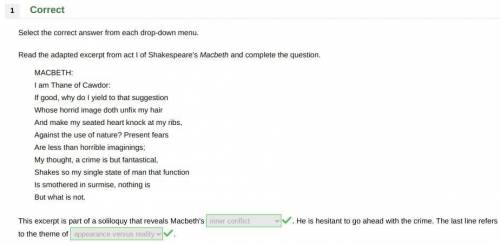
English, 28.10.2020 19:00, xxaurorabluexx
20 POINTS Macbeth Act I, Scene iii MACBETH: If good, why do I yield to that suggestion Whose horrid image doth unfix my hair And make my seated heart knock at my ribs Against the use of nature? Present fears Are less than horrible imaginings. My thought, whose murder yet is but fantastical, Shakes so my single state of man That function is smothered in surmise And nothing is but what is not In a short paragraph of 100-150 words, identify the theme in this passage and describe how the different aspects of it relate to and work together to build on theme. Evaluate whether or not this is an effective way to build on the theme. Justify your answer with evidence.

Answers: 3
Other questions on the subject: English

English, 22.06.2019 04:00, thevampsrock3
Read the passage. (1) since prehistoric times, milk has been a vital source of nutrition for human beings. (2) some doctors and nutritionists believe that consuming milk can be detrimental to our health. (3) milk is one of the most nutrient-dense beverages we can consume and it should be an essential part of a healthy diet. (4) drinking just one 8-ounce glass of milk per day puts you well on your way to meeting recommended daily intakes for important nutrients. which transition would be best to use at the beginning of sentence 2? finally additionally however specifically
Answers: 1

English, 22.06.2019 04:50, ilawil6545
Read the passage, then answer the question that follows. no one could have seen it at the time, but the invention of beet sugar was not just a challenge to cane. it was a hint—just a glimpse, like a twist that comes about two thirds of the way through a movie—that the end of the age of sugar was in sight. for beet sugar showed that in order to create that perfect sweetness you did not need slaves, you did not need plantations, in fact you did not even need cane. beet sugar was a foreshadowing of what we have today: the age of science, in which sweetness is a product of chemistry, not whips. in 1854 only 11 percent of world sugar production came from beets. by 1899 the percentage had risen to about 65 percent. and beet sugar was just the first challenge to cane. by 1879 chemists discovered saccharine—a laboratory-created substance that is several hundred times sweeter than natural sugar. today the sweeteners used in the foods you eat may come from corn (high-fructose corn syrup), from fruit (fructose), or directly from the lab (for example, aspartame, invented in 1965, or sucralose—splenda—created in 1976). brazil is the land that imported more africans than any other to work on sugar plantations, and in brazil the soil is still perfect for sugar. cane grows in brazil today, but not always for sugar. instead, cane is often used to create ethanol, much as corn farmers in america now convert their harvest into fuel. –sugar changed the world, marc aronson and marina budhos how does this passage support the claim that sugar was tied to the struggle for freedom? it shows that the invention of beet sugar created competition for cane sugar. it shows that technology had a role in changing how we sweeten our foods. it shows that the beet sugar trade provided jobs for formerly enslaved workers. it shows that sweeteners did not need to be the product of sugar plantations and slavery.
Answers: 1

English, 22.06.2019 05:50, krystlemiller11211
To protect consumers, the sec requires brokers and dealers to what? information about securities.
Answers: 1

English, 22.06.2019 08:00, bobduncan1086
Analysis that compares and contrasts the way two myths show one important feature of their culture
Answers: 2
Do you know the correct answer?
20 POINTS Macbeth Act I, Scene iii MACBETH: If good, why do I yield to that suggestion Whose horrid...
Questions in other subjects:




Law, 23.03.2021 20:20




History, 23.03.2021 20:20








